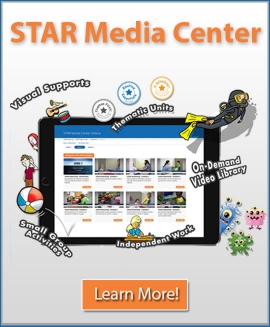Making the Principles of ABA Work for You
Don’t sweat the antecedent stuff!
Do you feel overwhelmed by the start of the school year? Do you wake up in a cold sweat thinking about how you are going to provide quality instruction, manage challenging behaviors, and monitor students’ progress? You are not alone. Thankfully, it’s easy to use a variety of behavior analytic strategies in any classroom to achieve long-lasting positive results in the areas of skill instruction and behavior management.
The National Autism Center has done the painstaking research to identify the most effective strategies to implement with students on the autism spectrum. As reported in the National Standards Project, Phase II (2015), behavioral interventions were the largest category of treatments and strategies shown to demonstrate their effectiveness with students with autism.
The STAR program incorporates a variety of those behavioral strategies, including but not limited to, modeling/imitation, repeated practice opportunities, use of task analysis, reinforcement, choice-making, and chaining of complex skills. All of these strategies have one thing in common…..drum roll….we can use them as antecedent strategies to set up our students for success in the classroom and other settings. As educators, we want to focus on antecedent strategies because they can prevent challenging behaviors from occurring, they act immediately on the environment, and they help us set up learning environments tailored to each students’ needs (Kern & Clemens, 2007).
One of the most pivotal antecedent interventions involves matching students’ instruction to their learning needs. In the STAR curriculum, we give you a tool to help you identify the skills students have and those they don’t, as well as a scope and sequence to help them achieve learning objectives. The Student Learning Profile (SLP) is a curriculum-based assessment designed for teachers and educational assistants to determine which lessons to teach from 5 to 6 curricular areas. Remember that the curricular areas are independent of one another. Your student could be working on Level II Receptive Language lessons while working simultaneously on Level I Expressive Language. Once the skills and lessons to be taught have been identified (great antecedent strategy), check out the STAR Media Center for videos of all of the lessons included in the curriculum!
Preparedness is not only an important antecedent strategy in emergency situations, but it’s critical in educational settings as well. If you’re short on ideas and/or time to get materials prepared for your students, the STAR Media Center provides thematic units complete with visual supports and downloadable activities for all to enjoy.
References
Kern, L. & Clemens, N.H. (2007). Antecedent strategies to promote appropriate classroom behavior. Psychology in the Schools, 44, pp. 65-75.
National Autism Center. (2015). Findings and Conclusions: National Standards Project, Phase II. Randolph, MA: National Autism Center.

